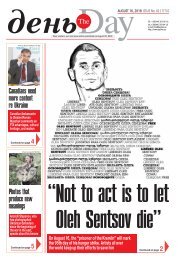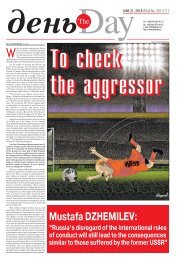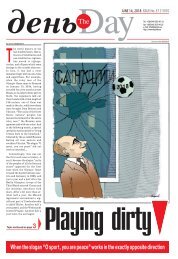#40_1-8
Create successful ePaper yourself
Turn your PDF publications into a flip-book with our unique Google optimized e-Paper software.
WWW.DAY.KIEV.UA<br />
CULT URE No.40 JUNE 26, 2018 7<br />
By Dmytro DESIATERYK, The Day,<br />
Dnipro – Kyiv<br />
Photos by Yurii STEFANIAK<br />
I’d long known about Ukraine’s<br />
first Anti-Terrorist Operation<br />
Museum in Dnipro before visiting<br />
it this year. It’s official title<br />
reads: “Museum [dedicated to]<br />
the Civil Feat of Dnipropetrovsk<br />
Oblast during ATO Events” and it is<br />
formally one of the Dmytro Yavornytsky<br />
National History Museum’s<br />
six branches. The exposition consists<br />
of the indoor diorama “Battle of<br />
Dnipro” and the outdoor display<br />
“Donbas Roads.” The diorama was<br />
opened on May 25, 2016, and the<br />
indoor exhibit on January 23, 2017.<br />
The main exposition occupies<br />
600 square meters of the diorama’s<br />
ground floor. Among the 2,000 items<br />
on display are documents, photos,<br />
war decorations, personal effects of<br />
ATO officers and men, weapons, and<br />
medical instruments. The multimedia<br />
room (movie theater) offers three<br />
panoramic documentaries (two in<br />
Ukrainian and one in English) about<br />
combat operations in the east of<br />
Ukraine.<br />
The outdoor display shows a BMP-<br />
2 infantry fighting vehicle, T-64 tank<br />
turret, PM-43 regimental mortar,<br />
other weapons, an UAZ-452-truckmounted<br />
ambulance, and a concrete<br />
mock-up of a roadblock. Practically all<br />
items on display are from battlefields.<br />
The central part of “Donbas Roads” is<br />
occupied by the sculptural composition<br />
“A Soldier and a Girl” and [a section<br />
of] a highway with road signs<br />
with the names of towns in Donetsk<br />
and Luhansk oblasts. Behind the armored<br />
infantry vehicle is a large metal<br />
structure portraying the debris of<br />
Donetsk Airport, a monument to the<br />
Ukrainian heroes who defended the<br />
airport for 242 days.<br />
The diorama’s ground floor has a<br />
lobby, a video hall (former movie theater<br />
for lectures illustrated by documentaries),<br />
and the Hall of Memory<br />
(former exhibition hall with a wall<br />
with pictures of heroes who forced the<br />
Dnipro River during WW II). In the<br />
lobby, items on display are mounted<br />
on metal structures symbolizing the<br />
ruins of Donetsk Airport. The walls<br />
are covered by camouflage netting.<br />
There are large thematic stands that<br />
tell about servicemen, volunteers,<br />
medics, resettlers from the enemyoccupied<br />
territories, chaplains, and<br />
media people in the field.<br />
The Hall of Memory has over<br />
500 photos of officers and men killed<br />
in action who were born and lived in<br />
Dnipropetrovsk oblast. There are<br />
glass cubes with personal effects of<br />
50 KIAs, including war decorations,<br />
documents, books, parts of uniform<br />
and equipment, some showing where<br />
they were hit by bullets or shell fragments.<br />
I was born and grew up in<br />
Dnipropetrovsk oblast, so I can’t help<br />
being emotional. The Battle of Dnipro<br />
Diorama is essentially and actually a<br />
sample of pompous clumsy Brezhnev<br />
propaganda (Leonid Brezhnev visited<br />
the place in the early 1980s, shortly<br />
before his death). The key element is<br />
a diorama portraying the forcing of<br />
the river near Dnipropetrovsk, executed<br />
in the true style of socialist realism,<br />
with a bulky foreground made<br />
of dummy blocks and trees. What attracted<br />
us kids at the time was, of<br />
course, the display of Soviet materiel<br />
ranging from an ancient howitzer to<br />
a jet fighter. We were thrilled to explore<br />
each item and no one knew – or<br />
cared to know – whether it had actually<br />
been used in combat.<br />
The ATO Museum has breathed a<br />
new life into this mass of granite and<br />
steel. Vehicles riddled by bullets,<br />
road signs with familiar placenames,<br />
KIAs’ personal effects, a panoramic<br />
movie theater – all this well<br />
Ukraine’s first ATO museum<br />
planned and multifaceted design<br />
makes one feel like reading a war<br />
novel or watching a war blockbuster,<br />
even taking part in a war scene, and<br />
certainly makes this museum one<br />
of the best in Ukraine.<br />
I spoke to a museum official and<br />
asked how the project began.<br />
“Natalia Khazan, a volunteer of<br />
the Ukrainian Defense Foundation,<br />
was among the first to conceive the<br />
idea,” the man said. “There were also<br />
servicemen, volunteers, and<br />
medics who had fought in the first<br />
battles of 2014-15. Even then we<br />
had quite a few items on display and<br />
eyewitness accounts. Our region is<br />
the closest to the front. We started on<br />
the project in February 2016. First,<br />
it was an outdoor interactive exposition<br />
meant for children, so they’d<br />
know who was fighting, with what<br />
and why. We used the History Museum’s<br />
downtown junkyard and commissioned<br />
Kyiv artist Viktor Hukalo<br />
to make the design. The first exposition<br />
occupied 1,000 square meters.<br />
Just imagine: the project was<br />
conceived in February and was<br />
launched on May 26. Three months of<br />
hard and enthusiastic work! The idea<br />
was approved by authorities on all<br />
levels. The title ‘ATO Museum’ is a<br />
popular one, compared to the official<br />
‘Civil Feat of Dnipropetrovsk Oblast<br />
during ATO Events.’”<br />
What was the main concept?<br />
“Honor the living and pay homage<br />
to the dead, from day one. We wanted<br />
people to see the courage and feats<br />
of arms performed by our officers and<br />
men. We walk down peaceful streets<br />
with a clear sky above, and we tend to<br />
forget that a war is being fought<br />
some 60 miles away.<br />
“The history of this war is illustrated<br />
in several sections. We place no<br />
emphasis on one group of people compared<br />
to the next. Servicemen, temporary<br />
displaced persons, volunteers,<br />
chaplains, medics, journalists, the<br />
whole of Ukrainian society, all of<br />
Ukraine that’s resisting the enemy.<br />
The main thing is to show the truth<br />
about this war. We combine outdoor<br />
with indoor displays. The outdoor<br />
part has large items on display and introduces<br />
the visitor to the war theme.<br />
The main exposition has three sections,<br />
including an interior one with<br />
six thematic blocks, the Hall of Memory<br />
where we pay homage to the KIAs,<br />
and a movie theater.”<br />
Which of these sections do you<br />
consider to be the most important<br />
one?<br />
“They’re all important. Whereas<br />
the Hall of Memory leaves your<br />
nerves on end, the movie theater is<br />
the heart of the exposition. As many<br />
as 560 residents of Dnipropetrovsk<br />
oblast have been killed in action and<br />
the Hall is dedicated to them. It<br />
wasn’t planned as an exhibition<br />
room, but then relatives and comrades-in-arms<br />
of KIAs started bringing<br />
various items. This part of the<br />
museum is an especially vivid evidence<br />
of the scope of this war and the<br />
level of [Russia’s] aggression. Visitors<br />
step inside and see photos lining<br />
the wall from floor to ceiling,<br />
50 show window cubes that tell the<br />
story in no uncertain words.<br />
“The movie theater offers documentaries<br />
in Ukrainian and English,<br />
each lasting 30 minutes. They are<br />
made so no one leaves the audience<br />
unperturbed. They show all people<br />
– servicemen, medics, volunteers,<br />
chaplains, journalists – whose<br />
photos and stories are included in<br />
the exposition. The movie theater is<br />
modern equipped, with 10 projectors<br />
securing a panoramic 360 o view.<br />
Kyiv is probably the only other<br />
place where such equipment is used.<br />
The technical aspect of the project<br />
was very complicated, considering<br />
that most video material originated<br />
from servicemen’s smartphones and<br />
had to be processed to be projected<br />
on the big screen, but we solved<br />
that problem.”<br />
What about the documentary in<br />
English?<br />
“Our museum is a mandatory part<br />
of the itinerary for all official delegations,<br />
including members of parliament,<br />
ministers, ambassadors, and<br />
presidents. This is proof that we did<br />
everything the right way.”<br />
How many visitors so far?<br />
“Our estimates show over 160,000<br />
in 2016-17. The important thing is<br />
that admittance is free. There are<br />
very many young people among the<br />
visitors as the museum is part of the<br />
high school curriculum. There are<br />
interesting related patriotic projects<br />
like the one known as ‘The Roads of<br />
Heroes’ when groups of high school<br />
students come to Dnipro from various<br />
parts of the region and visit the military<br />
base of the 25th Brigade. There<br />
they are shown personnel’s daily routine,<br />
materiel, meet with war heroes.<br />
In the end, they visit the museum and<br />
walk down the Alley of Memory near<br />
the building of the regional state administration.<br />
They spend a day doing<br />
very informative sightseeing. Our<br />
museum is modern also because it<br />
operates on an interactive basis.”<br />
Any items on display that have a<br />
special meaning for you?<br />
“They all do as each has a special<br />
history. We receive them from the<br />
demarcation line. There are no dummies.<br />
Each item on display is genuine.<br />
I’ll repeat myself: the Hall of<br />
Memory is of the utmost importance<br />
to me. Everything there is permeated<br />
with human pain. How will I ever<br />
forget a postcard from the mother of<br />
a fallen soldier. She wrote she didn’t<br />
need any documents confirming receipt,<br />
that one had to realize that her<br />
son would never read her happy<br />
birthday postcard. Another woman<br />
brought her son’s combat fatigues<br />
and asked the clothes to be displayed<br />
so one could see the caliber of the enemy<br />
bullet that had killed him.<br />
“There is a letter from a sixyear-old<br />
girl whose father was killed<br />
in action in July. She was to enter<br />
Grade 1 on September 1. She addressed<br />
her letter to other children<br />
her age, saying your daddies will take<br />
you to school on September 1, but my<br />
dad died in the war.<br />
“There are shell fragments and<br />
bullets we received from the Mechnikov<br />
Hospital. They are displayed<br />
along with excerpts from case histories.<br />
This is something we must remember.”<br />
I noticed that ATO vehicles are<br />
displayed alongside dummies from<br />
the ex-Soviet exposition dedicated to<br />
WW II, and that the rest of the museum<br />
is inside the building with<br />
Brezhnev’s monumental diorama.<br />
An interesting combination, isn’t it?<br />
“There is ideology and there is<br />
paying tribute to the fallen heroes.<br />
Another thing that makes our museum<br />
different from others is that it<br />
doesn’t impose any ideology on the<br />
visitor. The whole project is the result<br />
of a dedicated effort by hundreds<br />
of people. Some would come up<br />
with ideas, others would bring items<br />
to be put on display… There is no<br />
drawing any lines in such diversity<br />
and that’s why there is no officialism.<br />
Our museum is not a propaganda<br />
facility. We’re trying to be as<br />
unbiased as absolutely possible and<br />
we are grateful for every visit. We<br />
can see a new level of communication<br />
and mutual assistance. Our museum<br />
is one big symbol of Ukraine. There<br />
was the Battle of the Dnipro during<br />
WW II, there is a battle for the city<br />
of Dnipro going on. This is our<br />
cause. Ukraine will be there for as<br />
long as there is Dnipro.”
















